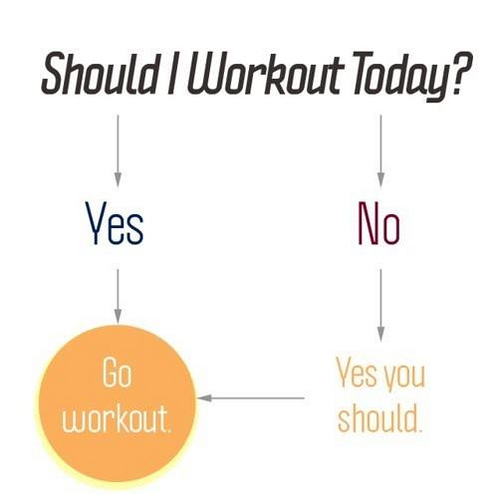Perhaps you were going to the gym and dieting for about month or two.
You were hitting the gym seven days a week. You were eating chicken and broccoli (aside from ingesting that putrid post-workout protein shake), and “meal prepping”.
Life was good.
But week after week, gym visits gradually decrease from seven day a week to two. Eventually, you find yourself passing it on the way home.
You lost your drive again and feel you “should’ go to the gym and “should” start dieting. However, you are not yet compelled enough to take action.
Sound familiar?
Over 394,935,284,939,294 individuals agree that it is difficult to start and sustain a fitness and nutrition program.
After all, your family responsibilities do not suddenly stop on the twelfth repetition of your bicep curls.
Your work deadlines do not diminish after the fourth round of your CrossFit circuit.
Use this step-by-step guide to kick-start your motivation and continue until you achieve your goal. The strategies that follow helped me accomplish the following:
• Earn a winning record as an amateur Mixed Martial Artist;
• Win multiple powerlifting competitions and compete at a national level;
• And lose 35 pounds to win my first-ever bodybuilding show.
The purpose of sharing these accomplishments is not to boast, but to add more credibility to the following recommendations.
Here are action steps for renewing your enthusiasm in your health and fitness goals.
How to Reboot Your Health and Fitness Motivation
Use the following five step formula to reboot your health and fitness motivation:
Step 1: Clarify Your Goal
Step 2: Define Your Purpose
Step 3: Formulate Your Plan
Step 4: Identify Your Obstacles
Step 5: Take Action Now
Step 1: Clarify Your Goals
“Begin with the end in mind” – Stepen Covey
What exactly do you want to achieve? When you initially think of health and fitness goals, what immediately comes to mind? What’s your number one goal?
Starting with a SMART (Specific, Measurable, Attainable, Realistic, and Timely) goal can be helpful in formulating a specific goal.
However, perhaps an even more effective goal setting technique to help narrow your objective is the SCAMPI technique. Setting SCAMPI goals involves focusing on several key aspects, as follows:
Specific – Instead of simply striving to “do your best”, crossing your fingers and hoping to “lose some weight for the summer”, formulate a specific goal.
Within your particular goal, create other specific “micro-goals” (e.g. how much time per week allocated towards cardiovascular and resistance training exercise). Break down your plan into smaller, more manageable steps.
Having a specific goal increases your chances for attaining your most important goal.
Challenging – Set a challenging goal to inspire you and keep you motivated throughout your program. Not only will setting a challenging goal be more motivating to pursue, but it will also afford more confidence and positive reinforcement for pursuing long-term health and fitness success.
Approach – Set your goal with a vision of what you want to occur, as opposed to an event or state you want to avoid.
An example of an avoidance goal is setting a weight-loss goal for your wedding to avoid criticism from other family members. While this can provoke immediate action (which is important, especially if considered overweight or obese with health concerns), for the long-term, focus on achieving a happy event or state.
Losing weight will help you to fit into your wedding dress, improve your overall health, increase your self-confidence, feel better in general, and have greater functionality to play with your family and friends.
Measurable – Measure your progress toward your goals through consistent self-monitoring and assessment. This allows for regular feedback to adjust your program with “proof” that you are improving over time (e.g., losing four inches off your waist or increasing your bench press by ten pounds).
With proof your training and nutrition program is making a positive impact, you’re more likely to maintain enthusiasm toward your goals.
Proximal – Create daily, weekly, and monthly goals to guide you in the direction of your primary goal. We recommend starting with smaller, easily-attainable goals. Not only will you gain momentum from your accomplishments, but it will also simplify your main goal by breaking it down into steps.
Your goal of losing 20 pounds will seem more doable when broken up into smaller steps. Your “micro-goal” may consist of losing four pounds by the end of June (an outcome goal) or following a specific macronutrient program daily (a process goal). Similarly, increasing your back squat from 450 to 500 pounds in six months may seem more feasible when increasing the weight you practice with by 10 pounds every two weeks.
Inspirational – Hallelujah! Well, not that type of inspiration. Indubitably, with your immediate goal set, you must have some underlying reason for wanting to accomplish it. Determine an inspiring goal that is aligned with your ideal state or situation.
Now that you have narrowed your goal using the SCAMPI principle, we will delve deeper into the “inspirational”.
Step 2: Define Your Purpose and “Why”
What is your “why”?
When I was in elementary and middle school, I struggled with being overweight.
Going to the department store and listening to my mom adamantly tell the attendant the size I was really looking for – “husky” – was not one of my fondest memories of childhood. (The frequent trips after school to McDonald’s were though, which I was rewarded regularly after school.)
As one of the heaviest kids in my elementary school classes, I was very frustrated and self-conscious about my weight.
Eventually, I decided to take action to change; high school marked a new chapter to recreate my body image. I began buying tons of fitness magazines and searching the internet for everything I could find on transforming my body. I started doing bodyweight exercises including push-ups, squats, and even pull-ups, using the dusty top portion of my room door.
When my family moved to an apartment, I begged the front desk employees to give me access as a 12-year old to the weight machines in the gym downstairs.
In high school, I joined the wrestling team when a football teammate claimed wrestling was the “hardest sport” and I would be unable to complete a season. Through the rigorous training and nutrition recommendations provided by my wrestling coach, I transformed my body and my life. While maintaining my weight around the 171-pound weight class, I lost body fat and packed on a significant amount of muscle.
Through a couple of years of proper nutrition and training, I started receiving compliments about my body. The positive affirmation, especially as an adolescent boy, was a huge boost to my self-esteem.
My “why” evolved from avoiding being teased about my appearance to pursuing, and helping other pursue, positive feelings of accomplishment and happiness.
Different people seemingly have unique motives for starting a fitness and/or nutrition program. However, the underlying motives are typically to feel better, live a fuller life, and be happier.
Invest time to be completely honest with yourself and understand why you truly want to achieve this outcome.
Goals can range from looking “slim and sexy” for the beach this summer to winning a physique competition to completing a Tough Mudder.
Regardless of your goals, dig deeper to uncover the underlying, emotional motives for wanting this to happen.
Anchoring purpose and emotion to your objectives will allow you to prevail over time, especially when passing your favorite fast-food establishment on the way home from work.
Step 3: Formulate Your Plan
“Proper preparation prevents piss-poor performance.” – British Army adage
So you have narrowed your goal and defined your purpose – now what?
To create a plan, the following are some simple steps for getting started:
1. Print out a calendar to use specifically for health and fitness planning.
2. Write your SCAMPI goal and your date of completion at the top of the calendar.
3. Schedule dates and times for a total of four to five hours of exercise per week and a meal preparation block.
4. Allocate your five hours toward different forms of training (i.e. resistance training, flexibility, cardiovascular exercise) depending on your goals.

On a separate but related note, as explained HERE, having a professional trainer or coach is invaluable. Following the guidance of a coach has the following advantages:
•Education
•Eliminate “Guesswork” (i.e. Programming, Nutrition Plan)
•Proper Exercise Technique and Safety
•Improve Self-Efficacy
•Help Formulate Goals
•Professional Guidance
•Accountability
•Motivation
•Save Time
Step 4: Identify Obstacles
What do you struggle with most when it comes to reaching your health and fitness goals?
One of the prevailing reasons people do not achieve their goals or start pursuing them is FUD (Fear, Uncertainty, and Doubt).
To help minimize these negative beliefs and maximize your belief in yourself, start by implementing the following techniques:
• Visualize – Visualization is an effective technique, used by many world-class athletes. However, anyone can utilize the power of visualization to help create their new picture of “being leaner” or “feeling stronger”. Practice visualization in a relaxed state and incorporate as many senses as possible.
• Schedule “Worry Time” – If you experience a lot of anxiety and worry while working out, schedule a separate 30-minute worry time. Ensure that you are in a positive mindset when training, whether on the treadmill or lifting weights. Aim to create a positive association with your gym visits or workout sessions.
If still experiencing distress during your workout sessions, another related technique is writing in a journal.
A journal I recommend to incorporate into your morning routine and bedtime routine is the 5-Minute Journal:
• Baby Steps – Have you heard the saying, “Rome wasn’t built in a day”? Encourage yourself by setting “mini-goals” for each day or each week and complete them. Then, gradually increase the level of difficulty of these goals and attain them, setting new ones until you reach your objective.
• List Your Successes – Regularly mapping your progress will enable you to see your past successes. Maintaining a fitness journal of your exercises with repetitions, sets, and weight used, can really make a difference in “seeing” your progress over time.
Step 5: Take Action
“Do the thing and then have the power.” Ralph Waldo Emerson
“Just Do It” – Nike
“No, seriously, get your @#$ up and go do it.” – T.J.C. Performance
What is your next best action step?
There are about 134,535,913,134,325+ quotes about fulfilling your goals and living a healthier, happier and fuller life. However, your success in completing your goals ultimately comes down to this statement:
Take action!

Taking action can be very difficult, especially when your chief aim involves changing deeply ingrained behaviors.
But once you start and consistently take action, your momentum and new habits will replace the older ones.
Furthermore, after you do take action, reward yourself with a healthy activity or treat such as a post-workout smoothie or protein bar.
With a reward and consistent positive reinforcement, you may be more inclined to repeat these behaviors and move closer toward your goals. Use the above recommendations only as a means to take action and remember that “baby steps” are still steps.
Conclusion
Here is the five-step formula for helping you reboot your fitness, nutrition, and health motivation:
Step 1: Clarify Your Goal – What Do You Want to Achieve?
Step 2: Define Your Purpose – Why Do You Want to Achieve Your Goal?
Step 3: Formulate a Plan – What Is Your Plan?
Step 4: Identify Obstacles – What Do You Struggle With Most?
Step 5: Take Action Now – What Is Your Next Best Action Step?
Start taking action NOW!
Once you do, persist toward your health and fitness goal until the goal is accomplished.
After all, your performance today towards your health and fitness goals is performance for life.
Questions? Comments? Feel free to drop a line below about “The Definitive Guide to Rebooting Your Health and Fitness Motivation”.







Great blog!